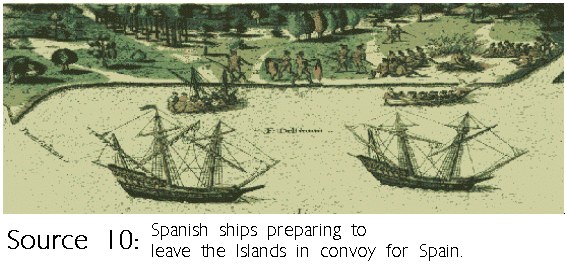
THE EARLY COLONISATION OF THE NEW WORLD BY THE SPANISH REQUIRED THAT THE LUCAYANS BE BRUTALLY TRANSPORTED TO DIE IN SLAVERY IN THE WEST INDIES; AND, WHEN FURTHER EXPLOITATION REVEALED NOTHING OF VALUE, THE ISLANDS OF THE BAHAMAS SLIPPED INTO OBSCURITY.
Early Colonisation
FOLLOWING AN INTERNATIONAL AGREEMENT, THE SPANISH SET ABOUT EXPLOITING THEIR NEW FOUND TERRITORIES, WITH DRASTIC RESULTS FOR THE INDIANS OF THE GREATER ANTILLES.
In 1492 a treaty was signed at Lordesillas involving Ferdinand and Isabella of Spain, the King of Portugal and Pope Alexander VI, agreeing that the newly discovered territories be divided at the line of longitude 50 degrees West; west of the line would belong to Spain, east to Portugal. Columbus turned out to be an ineffective governor, and the new territories remained unprofitable until Nicolas de Ovando came to Hispaniola in 1503. He introduced from Spain the Encomienda System, under which the Indians were forced to work for the Spaniards and pay them tribute, while in return the Spaniards offered 'protection' and conversion to Christianity. Under this system, the Tainos of Hispaniola died off fast. It is estimated that of the 300,000 that existed in 1492, only 60,000 remained alive in 1508, about 500 in 1550, and eventually, none.
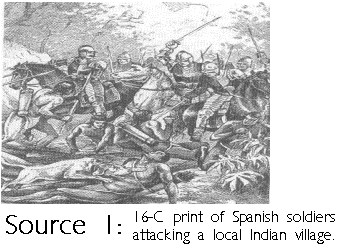
Brutally transported
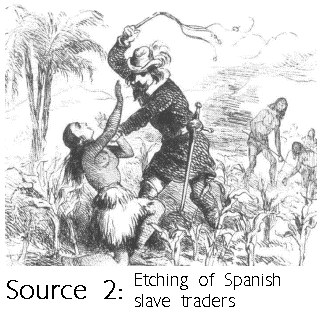
SPANIARDS SEARCHED THE BAHAMAS FOR SLAVES, CROWDING THEM ABOARD THEIR SHIPS SO THAT MANY OF THEM DIED BEFORE REACHING THEIR DESTINATION.
The demand for Indian workers encouraged Spanish traders and plantation owners to round up in the various islands of the Bahamas an estimated 20,000 Lucayans between 1500 and 1520. Some may have been tricked aboard slave ships with promises of being taken to heaven to meet their ancestors, but it is more likely that they were rounded up like cattle by armed Spaniards using dogs, and forced aboard. Crowded below decks with little food or water, many perished. According to Bishop Las Casas 'a ship going from Hispaniola to the Islands of the Lucayans sayl'd thither without any compasse, only by the carkasses up and down the sea'.

Slavery in the West Indies
ASSIGNED TO A VARIETY OF IMPOSSIBLE TASKS, THE LUCAYANS DIED OUT RAPIDLY, ALTHOUGH A FEW FOUND TEMPORARY REFUGE.
Many Lucayans laboured on Hispaniola to produce food crops, others to dig for gold; some were taken to the Margarita Islands, near Trinidad to dive for pearls. All had to meet the quota (fixed amounts) which was impossible to achieve. Weakened by the hard labour and lack of food, beaten savagely for not producing enough, the Lucayans died off quickly; some of European diseases such as smallpox, some by drowning or being eaten by sharks; some even committed suicide.
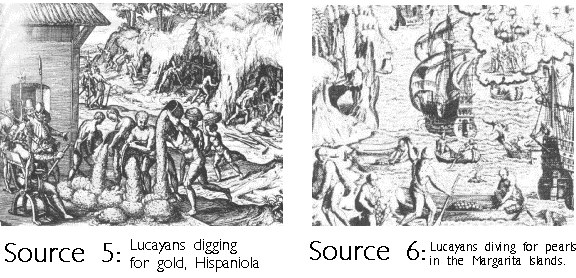

It was Bishop Las Casas who struggled to save the Indians; some time before 1520, he hired a ship to search the Bahamas for survivors. After three years, eleven Lucayans had been rescued and kept under Las Casas' protection.
Further Exploration
ONE FAMOUS SPANISH SOLDIER WAS ATTRACTED TO THE BAHAMAS BY LUCAYAN LEGENDS BUT EXPLORED THE ISLANDS IN VAIN.
One of the Spanish conquistadors who conquered Puerto Rico and went on to be Governor and Chief Justice was Ponce de Leon.
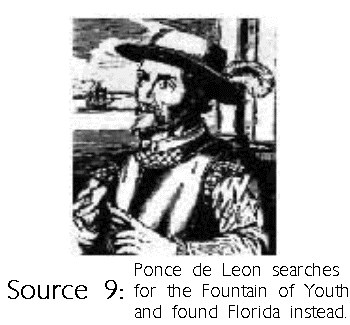
When he fell from power in 1511, he got permission to conquer the lands to the north. Now it was rumoured at this time that on the Island of Bimini, somewhere in the Bahamas, was a Fountain of Youth. According to the Spanish historian Peter Martyr there was 'a continual sprynge of runnynge water of such marvellous virtue that the water thereof being dronke... maketh owld men younge ageyne'. Setting out from Puerto Rico in March 1513 and returning in October, Ponce de Leon explored many Bahamian Islands, including Abaco, North Eleuthera, the Berry Islands and Andros, (he even landed in Florida), but he did not find Bimini, or the magical Fountain.
Slipped into Obscurity
LATER, THE EMPHASIS OF SPANISH COLONIALISATION SHIFTED AND A DIFFERENT RETURN ROUTE TO SPAIN WAS ADOPTED SO THAT THE WATERS OF THE BAHAMAS WERE AVOIDED.
Meanwhile important changes were taking place in the Spanish territories; in 1511 Diego Velasquez conquered Cuba and from there the Spaniards went on to conquer the vast wealth of the Aztec and Inca Empires. The port of Havana became the base for the treasure fleets returning to Spain in convoys. When Santa Domingo had been the capital of their empire, returning Spanish ships would use the Windward Passage to sail through the Bahamas to catch the Trade Winds. After Havana was established, returning ships would use the Florida Straits. The rocks and reefs of the 'shallow seas' of the Bahamas were dangerous, and to be avoided if possible. For example, in 1595, a fleet of 17 Spanish ships was wrecked off Abaco in a storm.
